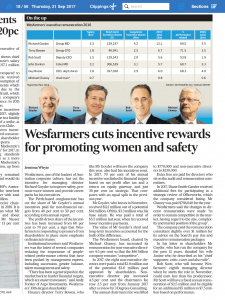 Today’s issue of the Australian Financial Review (AFR) contained an article that shows that the trend for companies and boards embracing their occupational health and safety (OHS) obligations is not uniform. The article “Wesfarmers cuts incentive rewards for promoting women and safety” reports that the Managing Director’s share of annual incentives paid for non-financial targets, which includes OHS, has been reduced from 40% to 30%.
Today’s issue of the Australian Financial Review (AFR) contained an article that shows that the trend for companies and boards embracing their occupational health and safety (OHS) obligations is not uniform. The article “Wesfarmers cuts incentive rewards for promoting women and safety” reports that the Managing Director’s share of annual incentives paid for non-financial targets, which includes OHS, has been reduced from 40% to 30%.
This reduction has been “balanced” by an increase in profit-driven incentives from 60% to 70%.
The article goes on to say:
“Institutional investors said Wesfarmer was the latest of several companies reducing the importance of people-related performance criteria that have been pushed by management experts, including succession, gender balance, talent management and safety.”
Argo Investments‘ Andy Foster is reported as saying:
“There has been a general push in the market back to harder financial targets, which are easier to manage.”
On the cusp of National Safe Work Month in Australia, this report and these comments are of great concern as they are counter to the messages coming from the OHS profession and OHS regulators. Leadership is supposedly key to the improvement of OHS performance and the agility of companies to respond to cultural change. What leadership is Wesfarmers and Argo Investments displaying?
There has been ongoing discussion about the OHS role played by executive incentives. Wesfarmers may state that this change will not affect (they’ll probably say “impact”) safety performance but Leadership is often about what is seen to be done as much as what is done. The reduction in incentives indicates that the safety of their workers is not as important as company profits. How will the company’s safety managers translate this to their employees?
Over the next few weeks when there is a lot of media about the importance of workplace safety, remember this AFR article, remember the words of Andy Foster, and ask yourself, would your company directors or employer act differently?
